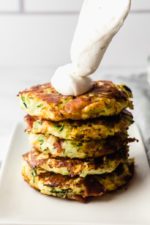Zucchini noodles are a healthier alternative to traditional pasta because they’re lower in carbs and calories. Plus, they’re a great way to sneak some extra vegetables into your diet and are the main ingredient in most keto pasta recipes.
Today’s article focuses on teaching you how to make zucchini noodles, also commonly referred to as zoodles. We’ll share some tips and tricks for getting the perfect noodle, and we’ll even showcase some of our favorite zoodle recipes at the end of our guide!
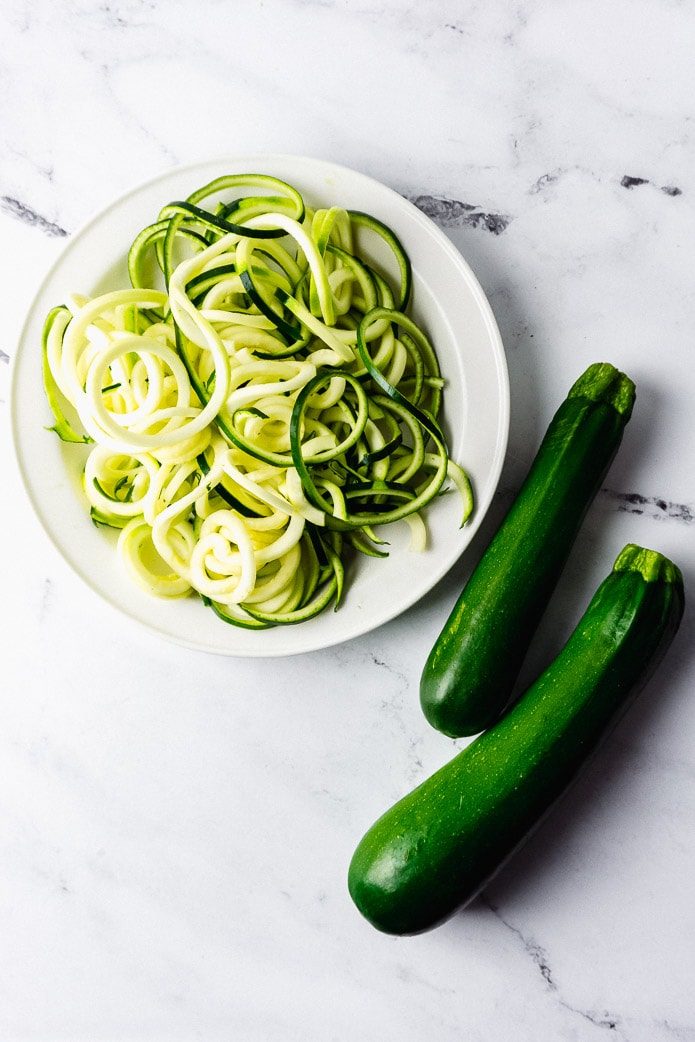
One of the biggest drawbacks of the keto diet is that almost all regular pasta dishes are off-limits. But, with a little creativity, you can still enjoy all your favorite foods – including pasta!
Unlike traditional pasta that requires flour and eggs, zoodles only require one ingredient: zucchini! And, unlike other keto pasta alternatives made with low-carb flour blends, these are gluten-free and grain-free.
Table of Contents
How to Make Zucchini Noodles With a Spiralizer
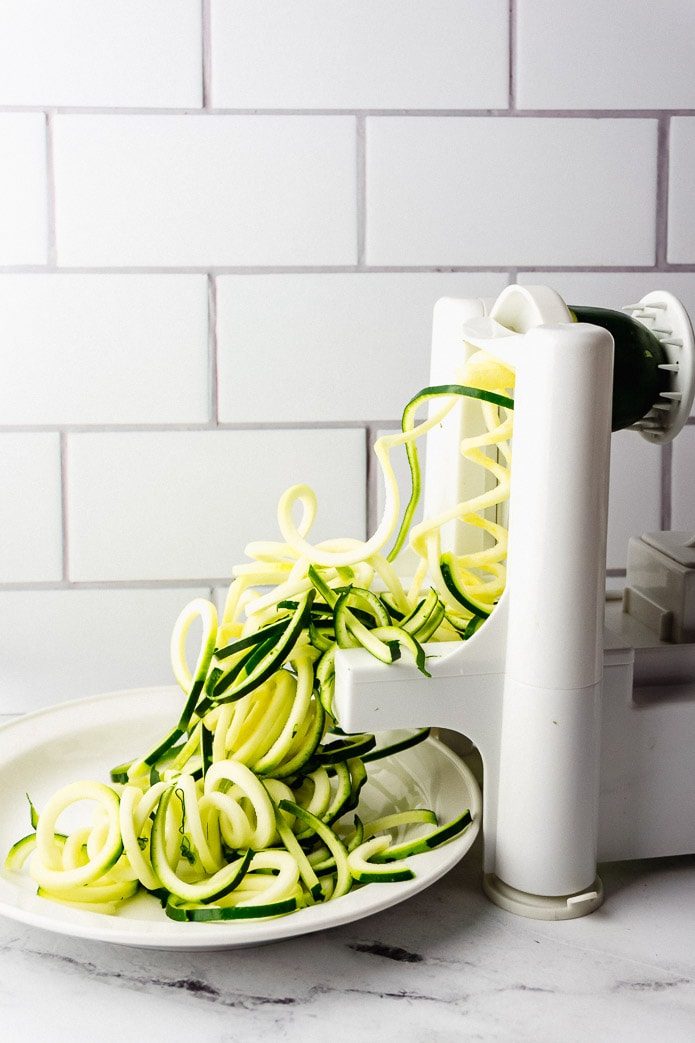
The easiest way to make zoodles is with a spiralizer. A spiralizer is a kitchen gadget that allows you to turn vegetables into long, noodle-like strands. It’s the perfect tool for making zoodles, but it can also be used to make other vegetable noodles, like carrot noodles and beet noodles.
There are different spiralizers, but the most popular ones are typical handheld spiralizers and the KitchenAid spiralizer.
KitchenAid Spiralizer
The most efficient kitchen tool for making zoodles is, by far, the KitchenAid spiralizer attachment.
It’s a time-saver because it attaches to your KitchenAid stand mixer and does all the work for you. You must feed the zucchini into the spiralizer attachment, and it does the rest.
The only disadvantage of this device is that it’s pretty big and bulky, so storing it will require that you free up some space.
Handheld Spiralizer

A handheld spiralizer is similar to an automatic one, except that you’ll have to use raw elbow grease to get the job done. But a handheld spiralizer will do the trick if you don’t mind a little arm workout.
The process of spiralizing zucchini with a handheld spiralizer is pretty straightforward:
- Hold the spiralizer in one hand and the zucchini in the other hand.
- Start simultaneously pushing and twisting the zucchini through the spiralizer.
- Stop when the zucchini is fully spiralized.
Besides, it’s cheaper and smaller than the KitchenAid spiralizer tool, so it’s a better choice if you’re short on storage space or have a limited budget.
How to Make Zucchini Noodles Without a Spiralizer
Not everyone is a big fan of kitchen appliances for just one job. If that’s the case for you, then don’t worry because you can still make zoodles without a spiralizer.
The best way to do it is by using a julienne peeler, mandoline slicer, or a sharp knife.
Julienne Peeler – Angel Hair Zucchini Noodles
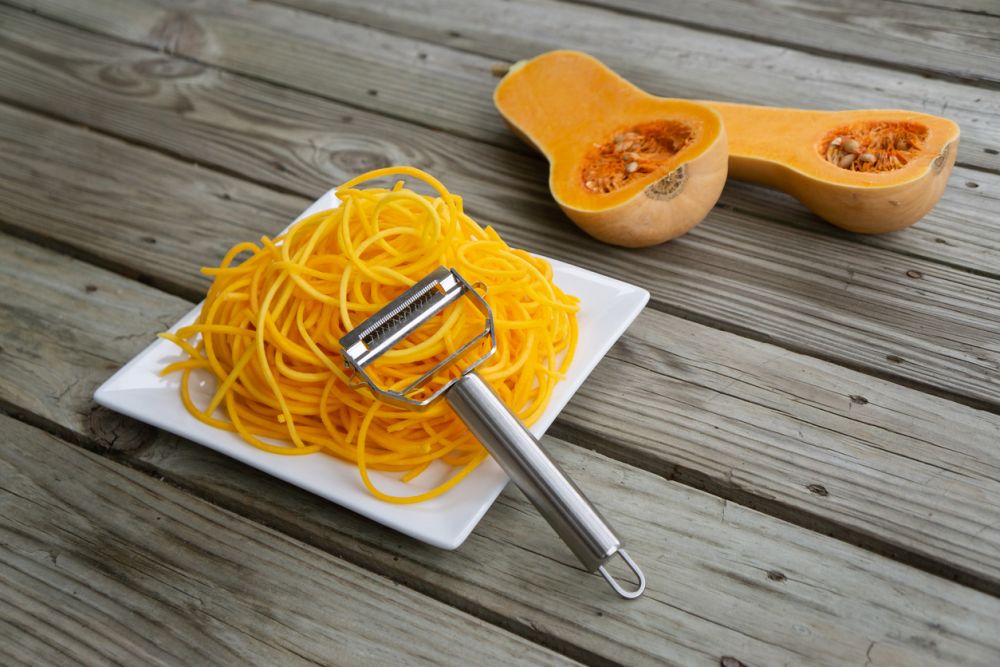
If you don’t have a spiralizer, you can use a julienne peeler to make zoodles. These tools will create thinner noodles than a spiralizer, but they’ll still get the job done.
For those unfamiliar with a julienne peeler, it’s a kitchen tool used to create thin strips of vegetables or fruit. It looks like a regular vegetable peeler, but the blade is serrated, creating long, thin noodles when you run it down the side of a vegetable.
The process of spiralizing zucchini with a Julienne peeler is identical to that of a vegetable peeler:
- Start by peeling off a thin layer of zucchini.
- Rotate the zucchini as you peel to create long, noodle-like strands.
- Stop when you’ve peeled off all the green skin or reached the seeds in the center of the zucchini.
The typical measurement for julienne is 3 mm × 3 mm × 40 mm–50 mm (0.12 in × 0.12 in × 1.57 in–1.97 in), so it’s an excellent tool for when you need to mimic extra-thin pasta like angel hair or spaghetti.
Mandoline – Fettucine Zucchini Noodles
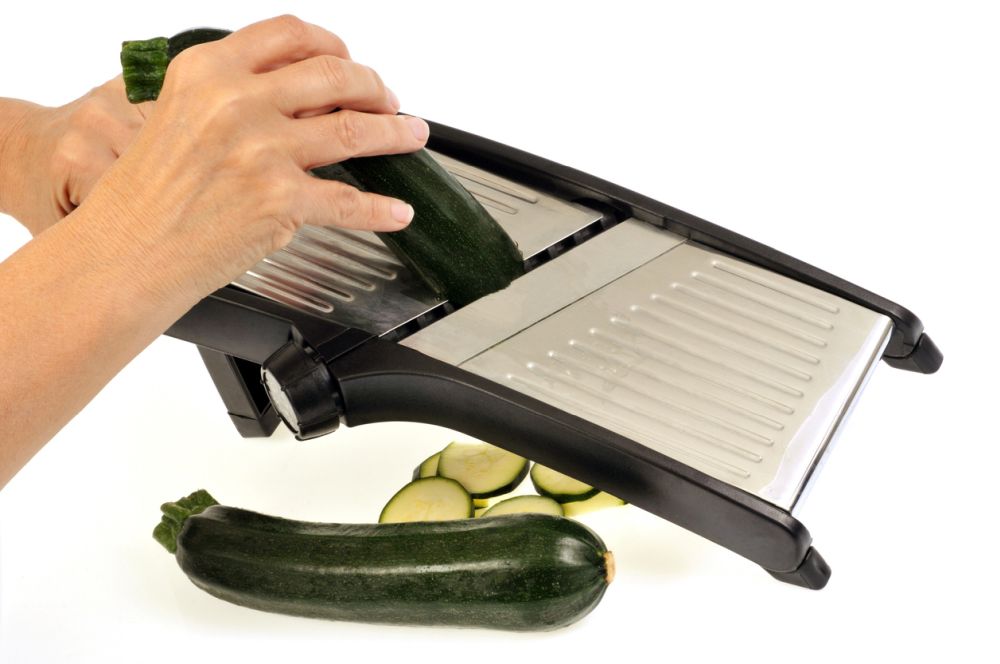
The idea of zucchini noodles is that they replace all kinds of noodles and pasta in your keto diet. So, if you were planning to make the keto version of a dish where you would have used fettuccine pasta, then you’ll have to cut your zucchinis in a way that will make them look like long, flat ribbons (from the Italian fettuccine).
Depending on your mandoline’s type of blade attachments, you may or may not need to use a knife. Some mandolines may only allow you to cut the zucchini into flat strips, so you’ll need a good knife to cut those strips lengthwise into long fettuccine pasta.
The best way to create zucchini fettuccine is to use a mandoline slicer, and then the process is pretty straightforward:
- Place the zucchini on the cutting board and line it up with the blade.
- Gently press down on the zucchini as you slide it back and forth to create thin, flat noodles.
Note: Be careful not to apply too much pressure because you don’t want the zucchini to go through the blade.
Vegetable Peeler – Pappardelle Zucchini Noodles
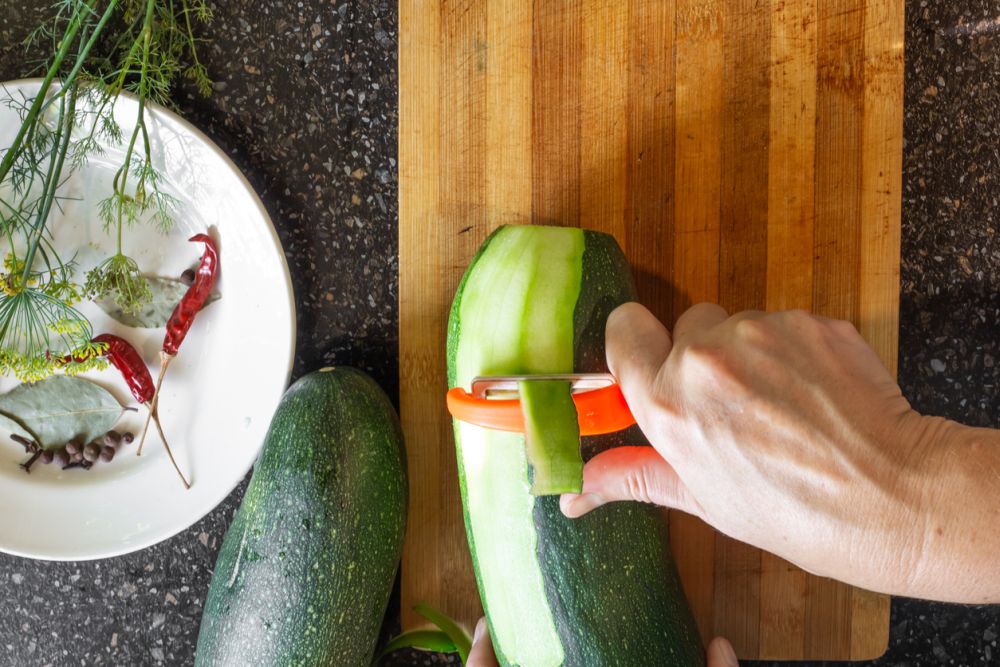
If you like your pasta to be even wider, then you’re probably a big fan of Pappardelle, a pasta originating from Italy’s Tuscany region.
The best way to create Pappardelle noodles out of zucchini is by using a vegetable peeler, and the process is similar to when you peel vegetables, only this time you don’t stop at the skin.
- Start by peeling a thin layer of zucchini.
- Continue peeling the zucchini, but without rotating it.
- Stop when you’ve reached the seeds or the strips are too thin.
Note: Use a knife to cut the noodles if you want them to be narrower.
Chef’s Knife – Lasagna Zucchini Noodles

Zucchini isn’t just great at replacing noodles and pasta; it can also be used to replace large pasta sheets from traditional dishes such as lasagna.
The best way to create lasagna noodles out of zucchini is by using a chef’s knife or a vegetable peeler. However, a chef’s knife would be better, especially since you’ll probably cut up an extra-thick zucchini or squash.
To cut up zucchini into lasagna sheets, follow these steps:
- Start by chopping off the ends.
- Cut the zucchini in half lengthwise.
- If the zucchini is extra-thick, then cut it in half again.
- Slice the zucchini into thin strips.
Unlike the other cutting methods, you won’t need to cut the strips into pasta anymore since you want your zucchini strips to be as wide as possible.
How to Cook Zucchini Noodles
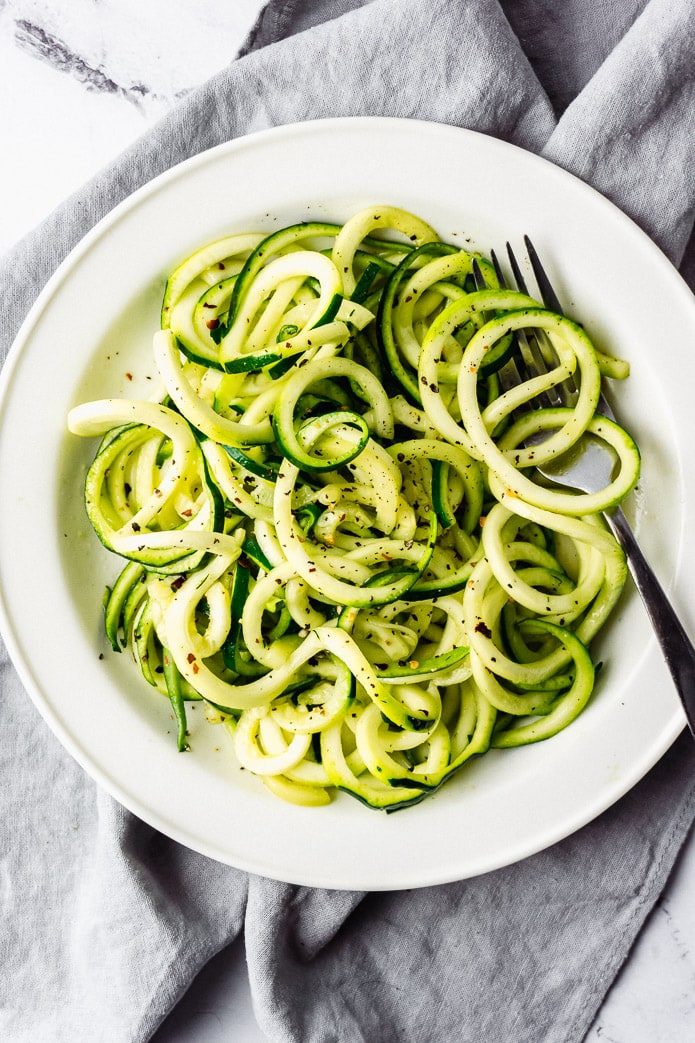
Zucchini noodles are pretty versatile and can be cooked in several different ways:
Serve Them Raw
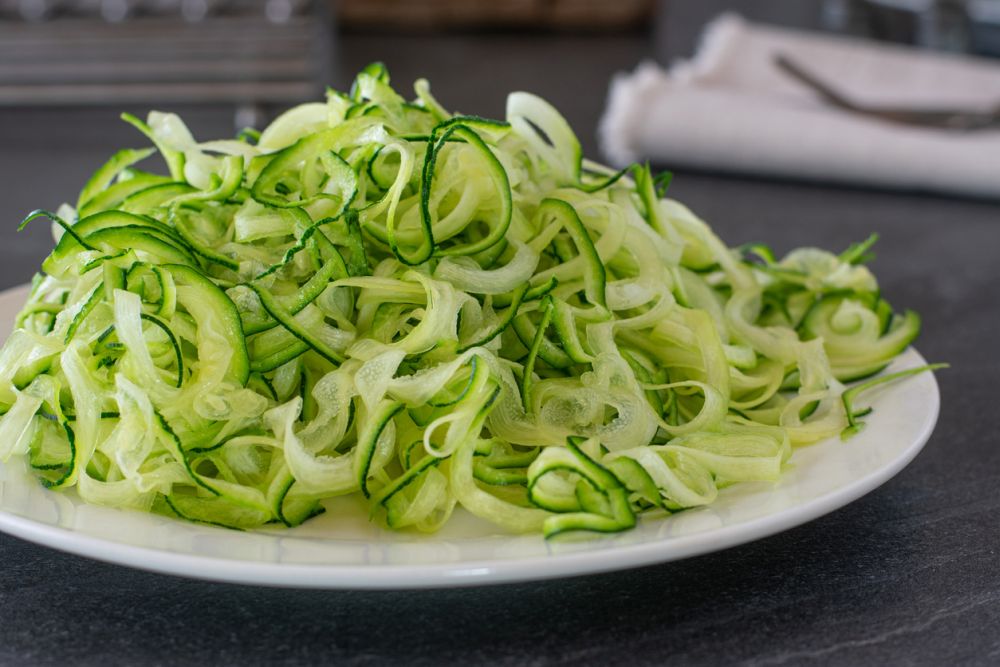
The first and easiest way to serve zucchini noodles is to not cook them. This is a great option if you want to enjoy the full flavor of the zucchini and don’t want to mask it with other ingredients.
Follow these steps:
- Peel and spiralize the zucchini into noodles.
- Place the noodles in a bowl.
- Drizzle with olive oil and season with salt and pepper to taste.
- Toss everything together until the noodles are coated in oil.
- Serve immediately.
Microwave Them
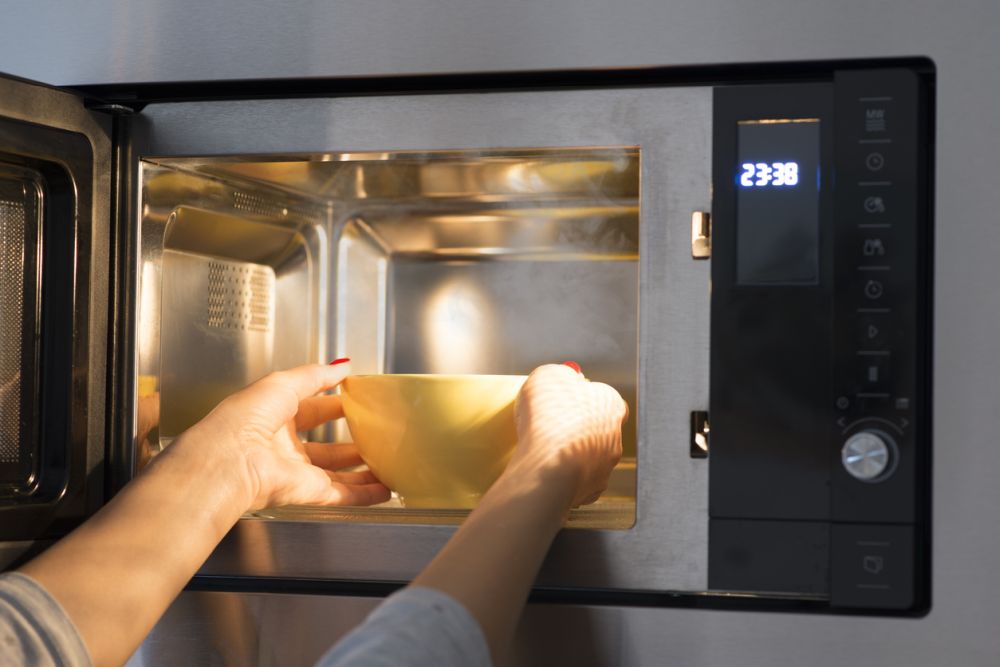
Since zoodles are made up of over 90% water, giving them a quick blast in the microwave is a great way to cook them without making them soggy. The key is not to overcook them; otherwise, you’ll end up with zucchini mush.
Here’s how to cook zoodles in the microwave:
- Peel and spiralize the zucchini into noodles.
- Place the noodles in a microwave-safe bowl.
- Add water so that the noodles are submerged.
- Microwave for 1-2 minutes or until heated through.
- Drain any excess water and season with salt and pepper to taste.
- Serve immediately.
Note: For best results, cook them in the microwave in 30-second increments to ensure that you get the consistency right (not all zucchini are the same).
Boil Them
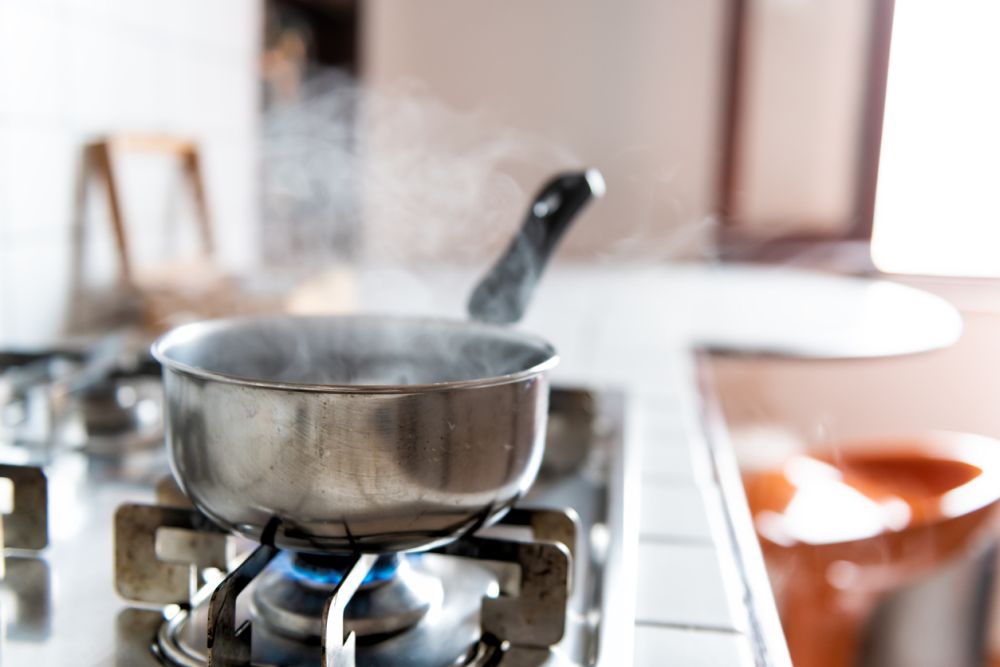
This step should sound familiar to those who are used to eating regular pasta. The process is pretty much the same; only you’re using zucchini noodles instead this time.
To boil zucchini noodles, do this:
- Peel and spiralize the zucchini into noodles.
- Bring a pot of water to a boil.
- Add the noodles and cook for 1-2 minutes or until heated.
- Drain any excess water and season with salt and pepper to taste.
- Serve immediately with your favorite sauce or toppings.
Note: Just like with regular pasta, it’s important not to overcook the zucchini noodles; otherwise, they’ll turn mush.
Saute Them

Another great way to cook zucchini noodles is to saute them. This cooking method is perfect if you want to add other ingredients to the mix, such as vegetables or protein.
To saute zoodles, simply:
- Peel and spiralize the zucchini into noodles.
- Heat olive oil in a large skillet over medium heat.
- Add the noodles and cook for about 1 minute or until slightly softened.
Note: Since zucchini noodles are very sensitive to overcooking, it’s best if you cook them separately from the other ingredients. If you plan on cooking them together, add the zucchini last.
Bake Them

The last cooking method you can use for zucchini noodles is baking them. This is a great option if you want to add them to a baked dish, such as lasagna or ziti.
To bake zoodles, follow these four steps:
- Preheat the oven to 200°F (93°C).
- Peel and spiralize the zucchini into noodles.
- Spread the noodles in a single layer on a baking sheet.
- Bake for about 10-15 minutes or until slightly softened.
Note: Like boiling and sauteing, it’s important not to overcook the zucchini noodles. It’s best to check on them every 2-3 minutes to ensure they don’t dry up or turn to mush.
Tips and Tricks: How to Make Zucchini Noodles less Watery
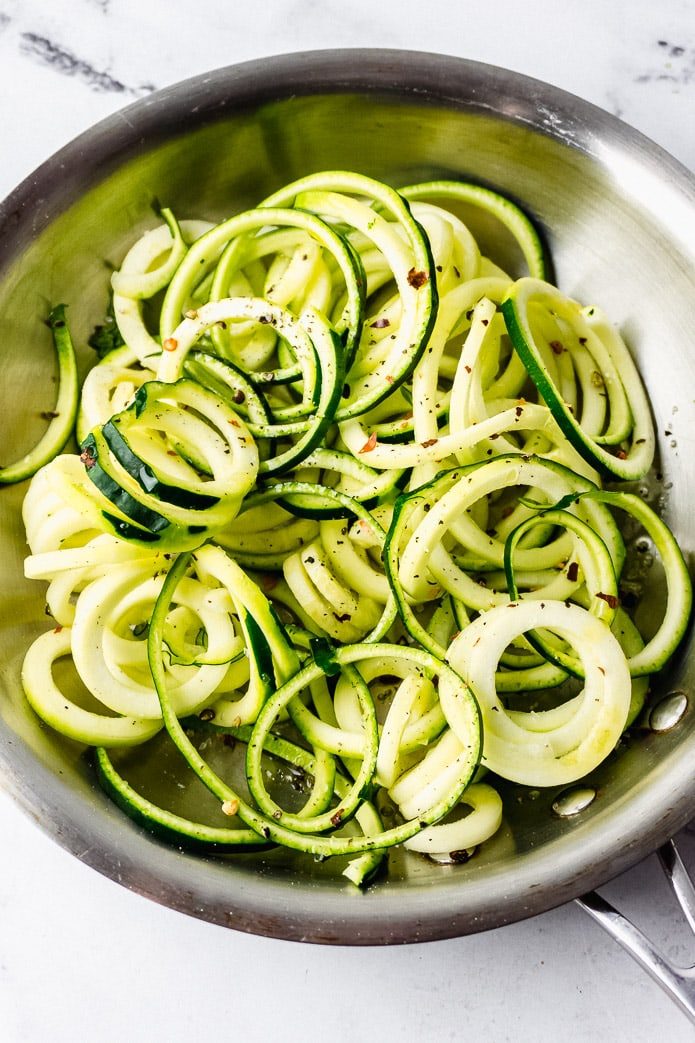
As we mentioned, zoodles are made of over 90% water. This means they can sometimes release a lot of liquid, making them watery and difficult to cook.
There are a few things that you can do to prevent this from happening:
- Pat them dry – once you’re done spiralizing your zucchini, pat them dry with a paper towel. This will help remove any excess moisture.
- Cook over medium heat – your goal is to promote water evaporation as much as possible, and cooking them over medium heat will remove excess moisture. Also, don’t cover the pot/pan with a lid since that will trap moisture inside.
- Don’t cook too often – an overcrowded pan/pot will trap moisture, so cook them in batches.
- Don’t salt them – while salting may sound like the perfect way to get rid of water, it does the opposite. It helps the zucchini retain all the water. If you want salt, add it to the sauce in which you’ll be covering the noodles.
- Don’t overcook the zucchini – the biggest issue with cooking zucchini (regardless of cooking method) is that they will eventually soften up and turn into a soft mush.
- Remove from the pot/pan when they’re done – residual heat from the pot/pan will continue to cook the zoodles, so they’ll continue to soften up even when you turn off the heat.
Recipes to Serve with Zucchini Noodles

Since zoodles are used in the keto diet as an alternative to regular pasta, pretty much any dish where pasta, spaghetti, noodles, or pasta sheets are used can be served with zucchini noodles. For example, we’ve included zoodles in our original recipe for keto lasagna.
Alternatively, you can serve these noodles alongside many great dishes, such as:
- Parmesan-crusted chicken breasts
- Keto ramen recipes
- Swedish meatballs
- Italian meatballs
- Salisbury steaks
- Stir fry recipes
- Pork belly
Frequently Asked Questions
The next section of our guide is going to answer some of the most frequently asked questions about zucchini noodles.
How do I store zucchini noodles?
You can prepare zoodles ahead of time and store them in the fridge for up to four days.
To store them, simply place them in an airtight container, but remember to line the inside with paper towels or some absorbent material. This will help remove any excess moisture, which can cause the zucchini to go bad.
Can you freeze zucchini noodles?
The best way to store any food is to freeze it, but certain foods don’t freeze well. Fortunately, zucchini is not one of those foods.
The folks of DIYS.com wrote a comprehensive article on the many ways to freeze and store zucchini noodles, so go ahead and give it a read if you’re interested.
Closing Thoughts
As you can see, zucchini noodles are a fantastic alternative to regular pasta. Not only are they low in carbs, but they’re also packed with nutrients and antioxidants. Moreover, they’re incredibly easy to make, and you can cook them in various ways.
If you’re looking for a delicious and healthy way to enjoy your favorite pasta dishes, give zucchini noodles a try. You won’t be disappointed!




